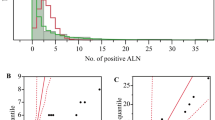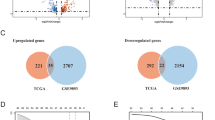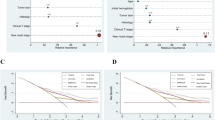Abstract
We investigated the association between pathological characteristics of primary breast cancer and degree of axillary nodal involvement and obtained a predictive index of the latter from the former. In 2076 cases, 17 histological features, including primary tumour and local invasion variables, were recorded. The whole sample was randomly split in a training (75% of cases) and a test sample. Simple and multiple correspondence analysis were used to select the variables to enter in a multinomial logit model to build an index predictive of the degree of nodal involvement. The response variable was axillary nodal status coded in four classes (N0, N1-3, N4-9, N > or = 10). The predictive index was then evaluated by testing goodness-of-fit and classification accuracy. Covariates significantly associated with nodal status were tumour size (P < 0.0001), tumour type (P < 0.0001), type of border (P = 0.048), multicentricity (P = 0.003), invasion of lymphatic and blood vessels (P < 0.0001) and nipple invasion (P = 0.006). Goodness-of-fit was validated by high concordance between observed and expected number of cases in each decile of predicted probability in both training and test samples. Classification accuracy analysis showed that true node-positive cases were well recognised (84.5%), but there was no clear distinction among the classes of node-positive cases. However, 10 year survival analysis showed a superimposible prognostic behaviour between predicted and observed nodal classes. Moreover, misclassified node-negative patients (i.e. those who are predicted positive) showed an outcome closer to patients with 1-3 metastatic nodes than to node-negative ones. In conclusion, the index cannot completely substitute for axillary node information, but it is a predictor of prognosis as accurate as nodal involvement and identifies a subgroup of node-negative patients with unfavourable prognosis.
This is a preview of subscription content, access via your institution
Access options
Subscribe to this journal
Receive 24 print issues and online access
$259.00 per year
only $10.79 per issue
Buy this article
- Purchase on Springer Link
- Instant access to full article PDF
Prices may be subject to local taxes which are calculated during checkout
Similar content being viewed by others
Author information
Authors and Affiliations
Rights and permissions
About this article
Cite this article
De Laurentiis, M., Gallo, C., De Placido, S. et al. A predictive index of axillary nodal involvement in operable breast cancer. Br J Cancer 73, 1241–1247 (1996). https://doi.org/10.1038/bjc.1996.238
Issue Date:
DOI: https://doi.org/10.1038/bjc.1996.238
This article is cited by
-
Questioning the role of axillary node dissection in sentinel node positive early stage breast cancer in the South Eastern Cancer Centre
Irish Journal of Medical Science (1971 -) (2015)
-
Significance of lymph vessel invasion identified by the endothelial lymphatic marker D2-40 in node negative breast cancer
Modern Pathology (2007)
-
Importance of the retro-mammary space as a route of breast cancer metastasis
Breast Cancer (2002)



